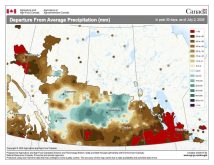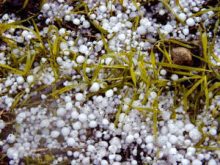Southwest Region
Normal to hot temperatures and variable rain events throughout week progressed crops rapidly. Subsoil moisture conditions have recharged with recent rains and provided crops with much needed moisture.
Winter wheat and fall rye typically are at the soft to hard dough stage, with some very advanced fields ripening. Fusarium infected kernels in heads are rare.
- Click here for the Crop Weather Report for the week ending July 22
Read Also

Manitoba sclerotinia picture mixed for 2025
Variations in weather and crop development in this year’s Manitoba canola fields make blanket sclerotinia outlooks hard to pin down
Spring cereal crops have completed flowering. Staging ranges from milk to hard dough in earliest seeded barley and wheat crops, but majority of staging is milk.
Canola, field peas and flax fields are finishing flowering. Seed are forming developing nicely and disease looks to be minimal in these crops.
Soybeans continue to flower with majority of crop at R3 (early pod) stage. Corn crops have tasselled are starting to show silks. Sunflowers are starting to have flowers open (R5).
Hay yields are average to below average and quality is good to fair. Recent rains may encourage regrowth for a second cut in some areas. Producers in the drier areas have started to seek out alternate feed sources. Past hay reserves were utilized during cool spring conditions, which has reduced feed inventories this summer. In some areas the pasture or water source will be a limiting factor for extended grazing and will further put pressure on this season’s hay crop. Most dugout are about 50 to 60 per cent full.
Northwest Region
Good growing conditions throughout the week with good soil moisture to support crops. Exceptions are in The Pas, where ponding occurring with excess water in low lying areas and north of Ste Rose where dry conditions continue to exist.
Winter Wheat and Fall Rye in the Ste. Rose and Roblin areas are in the dough stage with 50 per cent of the fields starting to ripen. Majority of the cereals, including wheat, barley and oats are in the milk stage, with about 40 per cent in the dough stage.
40 to 50 per cent of the Canola crop across the region is podding, with the remainder in the flowering stage.
20 to 30 per cent of the Soybean crop has reached the R3 stage, with the remainder in the R2 stage. Field peas and lentils are podded, and corn has begun to tassel.
Forage conditions vary across the region due to moisture levels. Yields in the western part of the region are 75 to 100 per cent of normal, while eastern yields estimated at 33 to 75 per cent of normal.
In The Pas, haying has started, but challenged with intermittent showers halting operations. Around Swan River, frequent showers have slowed hay harvest as well, but the moisture will benefit pastures and regrowth in fields cut early. Good haying progress made around Roblin and pastures are in good condition. Poor hay yields around Rorketon and pasture shortages are causing concern, dugout levels are very low.
Central Region
Warm temperatures with variable rain shower activity for the week have provided favorable growing conditions for crop development. Precipitation still needed to meet crop water demands during the long warm dry days and for grain filling as the plants mature. Dry pockets remain in the areas of Gladstone to Plumas, Cypress River to Rathwell, Altona to Emerson that have often missed scattered rain events.
Winter cereals are ripening with harvest expected to start within the next week in the Red River Valley. Spring wheat, oats and barley are progressing into the dough stage with some of the earliest fields already looking quite ripe, some barley has been swathed in the Red River Valley.
Most canola, flax and field pea fields are done flowering and pod/boll development is progressing. Some field pea fields begun drying down due to limited rainfall and will be harvested in the next week.
Sunflowers are in the late bud to flowering (R5) for the more advanced fields. Corn has tasselled and many fields already silking and pollinating.
Soybean fields are in the beginning pod (R3) to full pod (R4) and most advanced in the Red River valley. Edible bean fields are mostly done flowering and pod development is progressing.
Potato fields are progressing with warmer temperatures increasing water demands, irrigation is being applied as needed.
Pasture conditions are fair to poor and varies with the moisture conditions. Grasshoppers have been an issue in the Plumas area especially where pasture growth is poor from lack of moisture.
First cut of alfalfa mostly complete. Hay yields below normal due to the dryer conditions. Some second cut alfalfa taken where moisture was adequate, but most fields have poor regrowth. Livestock producers are considering alternative feed sources to complement their feed needs. Livestock water supply is adequate at this time but water levels are going down in dugouts.
Eastern Region
Hot and humid weather with some areas receiving high rainfall events resulted in another week of accelerated crop growth. Soil moisture conditions on crop land were rated as adequate in northern and central portions of the region and 50 per cent adequate to very short in the southern areas.
Winter wheat is at the hard dough stage.
Spring cereals are in the milk/soft dough stage.
Canola flowering is complete, with some concerns about heat blast during hot weather. Field peas are at pod filling stage and starting to turn.
Majority of soybeans are in the R4 stage. Sunflowers are flowering with average stage at R5.4. Corn is in tasseling to R1 silking growth stage.
Hay and pasture land is in need of rainfall to recharge soil moisture and encourage regrowth. Producers are rotating animals on pastures. Most haying has been cut or silage progress on first cut. Quality has been good, but yields are reduced, 50 to 75 per cent of normal. Second cut hay has begun. Good quality is expected and yields to be determined, producers are looking for more feed.
Interlake Region
Rapid crop advancement seen in most areas with high temperatures and scattered showers. All areas continue to look for timely rains, to sustain crops, allow for hay and pasture regrowth and replenish soil moisture.
Winter cereals crops are starting to be desiccated and earliest barley fields to be swathed within the week. Spring wheat and oat fields are turning colour and maturing.
Early seeded canola fields are done flowering and pods have formed. Later seeded canola is past the midpoint of flowering. Field peas are well podded, and are changing color with desiccation expected in next 10 to 14 days. Majority of flax fields have finished flowering.
Soybeans are in the R1 to early R3 stage, with many flowers evident. Most sunflowers at R2 to R4. Most corn fields have tasseled.
Some grass seed fields affected by dry conditions have had limited seed set, and will be cut for hay. Those with good seed set are swathed; harvest will start shortly.
The hay crop is variable due to scattered rainfall throughout the season, age of stands, level of fertility and insect pressure. Yields for first cut tame hay have been poor (33 to 50 per cent) to average. Rain needed to recharge soil moisture and assist in regrowth for second cut. At this point there is limited regrowth. Greenfeed is being cut with poor to average yields. Pastures are rated as poor with some hanging on with the scattered showers received recently.
Dugout water levels low; some producers are hauling and pumping water for livestock consumption.


















